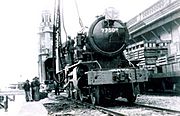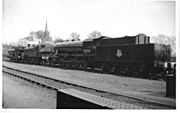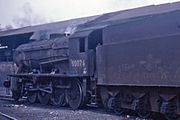WD Austerity 2-8-0 facts for kids
Quick facts for kids WD Austerity 2-8-0 |
|
 |
|
| 90733 at Haworth, 15 July 2007 | |
| Power type | Steam |
|---|---|
| Designer | Robert Riddles |
| Builder | |
| Build date | 1943–45 |
| Total production | 935 |
| Configuration | 2-8-0 |
| UIC classification | 1′D h2 |
| Gauge | 4 ft 8 1⁄2 in (1,435 mm) |
| Leading wheel diameter | 3 ft 2 in (965 mm) |
| Driver diameter | 4 ft 8+1⁄2 in (1,435 mm) |
| Length | 63 ft 6 in (19.35 m) over buffers |
| Axle load | 15 long tons 12 cwt (34,900 lb or 15.9 t) |
| Weight on drivers | 61 long tons 5 cwt (137,200 lb or 62.2 t) |
| Locomotive weight | 70 long tons 5 cwt (157,400 lb or 71.4 t) |
| Tender weight | 55 long tons 10 cwt (124,300 lb or 56.4 t) |
| Fuel type | Coal |
| Fuel capacity | 9 long tons 0 cwt (20,200 lb or 9.1 t) |
| Water capacity | 5,000 imperial gallons (23,000 L; 6,000 US gal) |
| Boiler pressure | 225 lbf/in2 (1.55 MPa) |
| Fire grate area | 28.6 sq ft (2.66 m2) |
| Heating surface: Tubes | 1,068 sq ft (99.2 m2) |
| Heating surface: Flues | 451 sq ft (41.9 m2) |
| Heating surface: Firebox | 168 sq ft (15.6 m2) |
| Superheater type | 28-element Melesco |
| Superheater area | 298 sq ft (27.7 m2) |
| Cylinders | Two, outside |
| Cylinder size | 19 in × 28 in (483 mm × 711 mm) |
| Valve gear | Walschaerts |
| Valve type | 10-inch (250 mm) piston valves |
| Tractive effort | 34,215 lbf (152.20 kN) |
| Power class | 8F |
| Nicknames | Ozzie |
| Axle load class | Route availability 6 |
| Disposition | One preserved, remainder scrapped. |
The War Department (WD) "Austerity" 2-8-0 was a powerful steam locomotive. It was first used in 1943 during wartime. A huge number of these locomotives were built, 935 in total! This makes it one of the most common British steam locomotives ever made. Railway workers often called them Ozzies.
Contents
Building the "Ozzie" Locomotives
The "Austerity" 2-8-0 was based on an earlier design called the LMS Class 8F. Robert Riddles made some changes to the design. The goal was to make them quickly and cheaply, even if they didn't last as long.
For example, the boiler was made simpler. It was straight instead of tapered. The firebox, where the coal burns, was round on top. It was also made from steel, which was easier to find and cheaper than copper during the war.
Two main companies built these locomotives:
- The North British Locomotive Company (NBL) in Glasgow built 545 of them.
- The Vulcan Foundry (VF) in Newton-le-Willows, Lancashire, built 390.
North British also built a larger version of this locomotive, called the WD Austerity 2-10-0.
Most of these locomotives were sent to mainland Europe to help the British Army after D-Day. Before they were shipped, their original WD numbers were increased by 70000. So, a locomotive numbered 800 would become 70800.
What Happened After the War?
After the war ended, the War Department decided what to do with the 935 locomotives. Most of them were sold off. Only two were kept by the War Department, and three were scrapped early on.
- British Railways: 200 locomotives were sold to the LNER. Later, in 1948, 533 more were bought by the British Transport Commission. When British Railways was formed, these 733 locomotives were given new numbers, from 90000 to 90732. One of them, No. 90732, was named Vulcan. This name honored the Vulcan Foundry where many of these engines were built.
- Hong Kong: In 1946, 12 locomotives were sent to Hong Kong. They worked on the Kowloon–Canton Railway. Most of these were scrapped by 1956, but two lasted until 1962.
- Europe: The remaining 184 locomotives stayed in mainland Europe. Many of them worked in the Netherlands for the Nederlandse Spoorwegen railway company. A couple of these Dutch engines were later sold to Swedish State Railways.
- United States: One locomotive even went to the USATC (United States Army Transportation Corps). This was part of an exchange for an American locomotive.
"Ozzies" Still in War Department Service
Two of these locomotives continued to be used by the War Department. They worked on the Longmoor Military Railway in Hampshire. In 1957, they were given new numbers: 400 and 401. One was named Sir Guy Williams and the other Major General McMullen.
Important Events and Accidents
- Soham Rail Incident (1944): On June 2, 1944, WD locomotive No. 7337 was pulling a freight train carrying bombs. The train caught fire near Soham, Cambridgeshire. The crew bravely tried to move the burning wagon away from the town. However, the cargo exploded at Soham station. The station was badly damaged. The railway line was fixed and reopened very quickly. For their heroic actions, the driver, Benjamin Gimbert, and the fireman, James Nightall, received special awards called George Crosses.
- Collisions in Germany (1945): On August 16, 1945, two WD locomotives, 77125 and 77238, crashed head-on near Kleve, West Germany. Both locomotives were too damaged to be repaired and were scrapped. Another collision happened on November 6, 1945, near Kranenburg, North Rhine-Westphalia, damaging NS 4485 (ex WD 77183). It was later written off.
- Ravenstein Collision (1945): On January 26, 1945, NS 4504 (ex WD 78693) was badly damaged in a head-on collision on a single-track bridge in Ravenstein. This locomotive was also later written off.
- Runaway Locomotive (1950): On September 17, 1950, WD locomotive No. 77195 rolled away from a shed in Leeds, Yorkshire. It crashed through the end of the tracks at a goods yard.
- Billingham Derailment (1953): On December 2, 1953, locomotive No. 90048 went off the end of a track loop at Billingham, County Durham. It was pulling a train at the time. Another freight train then crashed into the wreckage.
A Preserved "Ozzie"
Only one WD 2-8-0 locomotive has survived to this day! It was originally Vulcan Foundry works No. 5200. This locomotive was brought back from Sweden to the Keighley and Worth Valley Railway. In Sweden, it was known as SJ Class G11 number 1931.
It was fully restored to its original condition, which included building a new cab and tender. The restoration finished in 2007, and it became British Rail "No. 90733". After some test runs, 90733 pulled its first passenger train on July 23, 2007.
Gallery
-
90074 at West Hartlepool shed north-east of England (1967)
See also
- BR ex-WD Austerity 2-8-0 - locomotives of the class taken into British Rail service
- WD Austerity 2-10-0 - a similar but larger design




